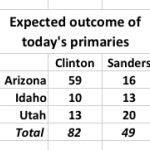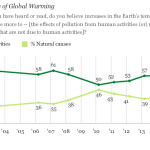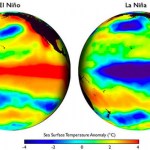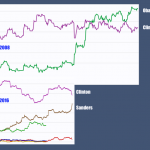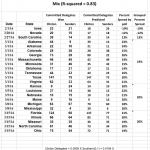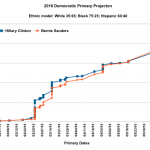
I'm trying to figure out how many Senate seats, and which ones, will switch from Republican to Democratic in November 2016.
At present, 54 Senator caucus with the Republicans, and 46 caucus with the Democrats (two of those are Independant).
We should be shooting for a good majority of 61, just to be safe. That means fifteen Republicans have to go, to result in a 39 to 61 mix. To get a simple majority, only five Republicans have to be replaced, to produce a 49 to 51 mix. So, we should be working for replacing fifteen but hoping to replace at least five.
A perusal of The Internet…
I met a student, I was on his examining committee, who had been a civil engineer for years (he was getting his undergraduate degree late in life). He was politically conservative and cynical about academia. He needed the degree in order to get a major promotion, hated the idea of going back to college, but he held his nose and did it anyway.
Part of the examination process involved asking the student how the completed degree program had changed is life. In this student’s case, one might expect the answer to have focused on the simple fact of getting a doubling in salary and promotion to the…
Bernie Sanders has either stated or implied two features that make up his strategy to win the Democratic nomination to be the party's candidate for President this November.
Implied, sort of stated: Convince so-called "Superdelegates" (properly called "uncommitted delegates") in states where he has won to vote for him, even if he is in second. That is a good idea, and if the two candidates are close, it could happen. However, when I run the numbers, giving Bernie "his" uncommitted delegates and Hillary "her" uncommitted delegates, it is pretty much a wash. The uncommitted delegates are not…
You know about Boatie McBoatface, so I won't bother telling you about it.
Did you know, though, that the guy who originally suggested, on Twitter, this name for the polar research vessel actually voted for the RRS David Attenborough?
I love the name Boatie McBoatface, as does everyone, but I also voted for a different name. I voted for the RSS Science.
And you should do. Here.
This post was written in two parts, pre-primary and post-primary. To see the result and a discussion of what they mean, skip down to the last part of the post, where I'll discuss why Tuesday's results may mean that Sanders could win the primary.
Pre-Primary
As already discussed, Clinton is likely to win the Democratic nomination. Sanders is too far behind to catch up without extraordinary results, as outlined here. However, it is also true that Sanders is likely to win a majority of contests from here on out, while at the same time, Clinton is likely to win many (if not most?) of the actual…
Remember that movie, The Day After Tomorrow? Check out this (not too new but still very current) video by Greenman3610, with Stefan Rahmstorf">Stefan Rahmstorf, Jason Box, and Michael Mann, looking at the real life version of that phenomenon.
There are three kinds of books that count as animal (usually bird) guides.
1) A pocket field guide of the critters of a reasonably circumscribed geographical area, like the Peterson Field Guide to Birds of Eastern and Central North America. This is a small book that can fit in a big pocket, and a classic guide like this one is something you'll want to have with you while bird watching in the eastern or central US.
2) A big book, not suitable for pockets, of the critters of a reasonably circumscribed geographical area. A great example of this is The Crossley ID Guide: Eastern Birds . It…
Though not enough. And for the wrong reasons. But this is still good news.
Somewhere around 1990, but you could justify an earlier date if you like, science knew enough about global warming, the increase in the planet's surface temperatures caused by human release of greenhouse gas pollution and other human effects, to have initiated meaningful action to shift our energy supply away from fossil fuels. We didn't know exactly what would happen, but we knew stuff would happen. How long has it taken for this science to turn into effective policy to address global warming? We don't know, because…
The US NOAA has this video summarizing what they expect for weather in the US as the result of the current, winding down, El Nino:
2016 Spring Climate and Flood Outlook
As a near-record El Niño begins to wind down, NOAA issued its spring seasonal outlooks for flooding, drought, precipitation, and temperature. Flood risk is highest in the lower Mississippi valley and along the Southeast coast. Learn more at: http://go.usa.gov/c7xYx
Posted by NOAA Climate.Gov on Thursday, March 17, 2016
UPDATED: The graphic above is updated from the original post to show the delegate counts this year through the New York Primary. I've also added the projected delegate counts based on my model, as dashed lines, through the end of the primary.
A while back I posted an item comparing the current, 2016, Democratic primary process with the 2008 primary that mainly involved Hillary Clinton and Barack Obama. I posted the following graphic comparing the Real Clear Politics polling data summary over the course of the primary cycle. That was at a point in time when Bernie Sanders was gaining on…
Almost exactly 50% of the votes have been cast in the Democratic Party primary and caucus process. I've been updating a model to predict primary and caucus results all along, and the model has done fairly well. The most recent update, however, was a bit off. That update involved separating states into two groups, southern vs northern, then calculating different sets of likely voting patterns by ethnicity for those two groups, and integrating that with estimates of ethnic distribution ("white, black, hispanic") among Democratic voters by state.
What I did not do in those models was to…
I'm starting this post before any primary results are in, and I'll add the outcome of the primaries below, where I will also compare the results to my predictions and discuss what I think this means for the overall process of the Democratic primaries. But first, I wanted to get some thoughts down to contextualize my thinking on this. I'll publish this post now, at mid-day Tuesday, so look for an update late Tuesday night, or early Wednesday.
I like Hillary Clinton, and I often think that her presidency would be better than a Sanders presidency, with an inaugural in 2017. This is based on…
Rotavirus vaccine is very effective in preventing this diarrhea inducing stomach illness in children in developed countries. But it appears that in certain poorer regions, i.e. Bangladesh, the same vaccine has a reduced effect, inducing sufficient immunity in fewer than half of the children who receive it. In the early days of the polio vaccine, a similar pattern was observed.
Why is this? What can be done about it? What does it all mean?
We interviewed Carina Storrs -- who visited the affected areas and has been writing about it over recent weeks -- here, at Ikonokast. Carina is a…
The latest National Geographic Roundtable Question: Survivor-style television has grown increasingly popular over the years and done a great job of illustrating our brain's fascinating built-in survival instinct. What role do you think our ancestral instincts play today in helping us survive, thrive and accomplish our goals? How much of our ancestral survival instincts are innate verses learned?
First, the innate vs. learned part of the question. This is a false dichotomy. We have evolved to learn. We probably have "built in" mechanisms to learn new things. This means that when we have…
Speech by a famous feminist on the importance of empowerment of women in the business world:
I was chatting with a friend the other day about the whole Bernie Sanders vs. Hillary Clinton thing, and it occurred to me that there might be a pattern of independent office holding in the US, especially in Congress. I had the impression that the Northeast and Minnesota, together, had the lions share of such individuals. It turns out I was partly right and partly wrong.
Going back through the 1970s, and for the heck of it, including Governors, there have been 19 such individuals, and they are indeed concentrated in the Northeast (with a couple in Minnesota, as well as Alaska, Virginia, and…
Most polls and FiveThirtyEight predict a Clinton blow-out on Tuesday, with her winning all five states, in some cases by a large margin. My model, however, predicts that each candidate will win a subset of these states, but with Clinton still win the day.
I’ve been working on a model to predict primary outcomes for the Democratic selection process, and generally, the model has proved very effective. After each set of primaries I’ve adjusted the model to try to do a better job of predicting the upcoming contests. The most important adjustment is the one that affects the current model.
The…
I have been presenting various versions of a model to predict the outcome of upcoming Democratic primaries. The earlier version of the model worked like this: Make some assumptions about the ratio of voting preference (for Sanders vs. Clinton) among the different major ethnic groups, and using the known distribution of said ethnic groups, predict the future.
I started out with the assumption that among whites, the ratio would be 50:50, based on one datum, the outcome from Iowa, which is essentially a white state. I used a bias for African Americans and Hispanic voters favoring Clinton.…
Climate Hawks Votes is running a primary in which you can chose either Hillary Clinton, Bernie Sanders, or No Endorsement.
The web page where you can vote is here. You are required to enter some identifying information in order to eliminate or significantly reduced gaming of the poll, so the results should be reasonably fair.
There is a tendency for climate hawks (using the term generally, not in reference to this specific group) to favor Sanders on climate over Clinton, because Clinton is not 100% anti-fracking and anti-methane, while Sanders is. However, I think this is a bit unfair.…
I developed a predictive model for the Democratic primaries that was designed to have the following features:
1) It does not rely on polling;
2) It does use exit polling and other information to set certain parameters;
3) It mainly uses prior primary or caucus results to predict the future, and thus assumes that the status quo is the best indicator.
4) It calculates likely voting patterns based on ethnicity (White, African American, Hispanic), and using likely Democratic party distribution among these groups to predict each contest's outcome.
That method outperformed most other predictions…




